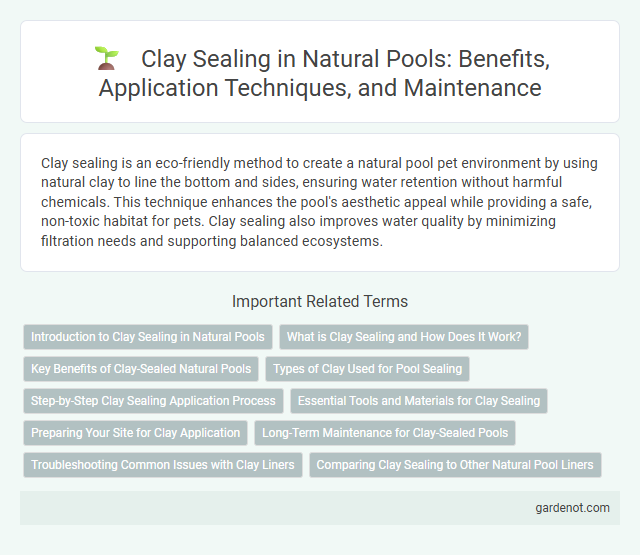Clay sealing is an eco-friendly method to create a natural pool pet environment by using natural clay to line the bottom and sides, ensuring water retention without harmful chemicals. This technique enhances the pool's aesthetic appeal while providing a safe, non-toxic habitat for pets. Clay sealing also improves water quality by minimizing filtration needs and supporting balanced ecosystems.
Introduction to Clay Sealing in Natural Pools
Clay sealing in natural pools involves using bentonite clay to create an impermeable layer that prevents water loss through soil seepage. This technique enhances water retention by swelling upon contact with water, filling soil pores effectively without the need for synthetic liners. Clay sealing supports eco-friendly pool construction by maintaining natural aesthetics and promoting sustainable water management.
What is Clay Sealing and How Does It Work?
Clay sealing is a natural waterproofing technique used in constructing natural pools by applying a dense layer of clay, typically bentonite, to the pool base and walls. This method works by the clay's unique swelling properties when wet, which fill gaps and create a tight, impermeable barrier that prevents water seepage. The effectiveness of clay sealing depends on proper compaction and thickness, ensuring long-lasting water retention without synthetic liners.
Key Benefits of Clay-Sealed Natural Pools
Clay sealing in natural pools provides exceptional water retention by forming a dense, impermeable layer that prevents leakage. This eco-friendly method eliminates the need for synthetic liners, reducing chemical use and minimizing environmental impact. Its durability and natural composition enhance the pool's aesthetic integration into the landscape while promoting healthy aquatic ecosystems.
Types of Clay Used for Pool Sealing
Bentonite clay is the most popular type used for natural pool sealing due to its high swelling properties and impermeability, effectively preventing water leakage. Sodium-based bentonite expands when wet, creating a dense barrier that seals pool floors and walls efficiently. Other types, like kaolin and illite clays, are occasionally used but generally offer lower sealing performance compared to bentonite in natural pool applications.
Step-by-Step Clay Sealing Application Process
Clay sealing in natural pools involves applying a dense layer of bentonite clay to create a natural waterproof barrier. Begin by thoroughly cleaning and smoothing the pool base, then spread a uniform layer of powdered bentonite clay, compacting it tightly to prevent water leakage. Finish by adding a protective layer of sand or soil to secure the clay while maintaining the pool's ecological balance.
Essential Tools and Materials for Clay Sealing
Essential tools for clay sealing in natural pools include a wheelbarrow for mixing, a sturdy shovel or mixing hoe, and a trowel for applying the clay. Key materials consist of high-quality bentonite clay, clean water, and sometimes sand to enhance the sealing layer's effectiveness. Proper preparation ensures a watertight natural pool liner that maintains ecological balance and durability.
Preparing Your Site for Clay Application
Ensure the pool base is thoroughly leveled and compacted to prevent uneven clay sealing and water seepage. Remove all debris, roots, and sharp objects that could puncture the clay liner during or after application. Gradually moisten the soil to achieve optimal plasticity, allowing the clay to form a dense, impermeable barrier essential for natural pool waterproofing.
Long-Term Maintenance for Clay-Sealed Pools
Clay sealing in natural pools ensures a durable, impermeable barrier that minimizes water loss and contamination over time. Regular inspection and maintenance of the clay layer prevent cracking and erosion caused by seasonal changes or aquatic activity. Proper care extends the lifespan of the clay seal, reducing the need for frequent repairs and preserving water quality effectively.
Troubleshooting Common Issues with Clay Liners
Clay sealing in natural pools often encounters issues such as cracking and leakage due to improper compaction or drying conditions. Addressing these problems requires rehydrating the clay liner and ensuring uniform compaction to restore impermeability. Regular inspection for signs of erosion or punctures helps maintain the integrity of the clay seal over time.
Comparing Clay Sealing to Other Natural Pool Liners
Clay sealing offers a highly effective, eco-friendly solution for natural pools, creating a watertight barrier that is chemical-free and durable. Unlike synthetic liners such as EPDM or PVC, clay provides excellent natural filtration and maintains a more organic pool environment. While synthetic liners may be easier to install, clay sealing excels in longevity and sustainability without introducing pollutants.
Clay sealing Infographic

 gardenot.com
gardenot.com